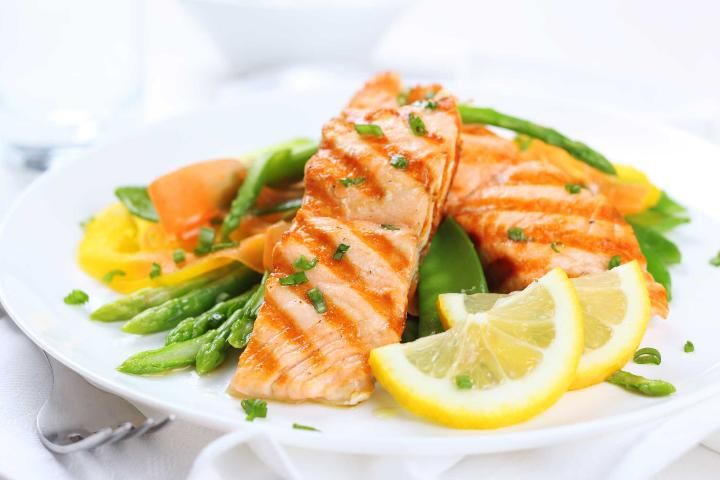Shopping for Health: Seafood
Seafood is a general term for all types of fish and shellfish. Seafood is part of the "protein foods group" of MyPlate and provides other nutrients needed for good health (USDA n.d.). As there are many health benefits associated with including seafood in one's diet, it is recommended that adults consume at least eight ounces of a variety of seafood every week (USDA and USDHHS 2020). Pregnant and breastfeeding women should aim to eat 8–12 ounces of a variety of seafood each week (USDHHS and USDA 2020). While eating more seafood is recommended as part of a healthy diet, it is important to consider your budget when shopping for seafood. This article explains the health benefits of seafood and offers some money-saving strategies for making seafood more affordable.

Credit: Elena Gaak/iStock/Thinkstock
What makes seafood healthy?
Seafood intake supports good health. Compared to many other popular sources of protein, seafood is low in saturated fat and is a good source of healthy fats such as omega-3 fatty acids (USDA n.d.). Seafood, like most lean meats, is a good source of B vitamins, as well as selenium, zinc, iodine, and iron (USDA n.d.). Some varieties of seafood, such as salmon and canned light tuna, are sources of vitamin D, a nutrient that is very important for bone health. Seafood provides protein that your body needs for healthy growth, maintenance, and repair. A three-ounce serving of seafood generally provides up to 40% of the daily protein requirement for adults (IOM 2005).
Scientific studies link seafood consumption with a reduced risk for heart disease (Mohan et al. 2021). Eating two servings of seafood per week may reduce the risk of heart attack and stroke (USDHHS and USDA 2020). This reduction in risk may be in part due to the omega-3 fatty acid content of seafood. Some fish, like salmon and herring, are naturally higher in fat and have higher omega-3 fatty acid contents.
When deciding which seafood to purchase, think about the omega-3 fatty acid content of different varieties. Options that have moderate to high levels of omega-3 fatty acids include salmon, mackerel, herring, and sardines which are considered "fatty" ocean fish. The omega-3 fatty acid content of a selection of seafood is shown in Table 1.
What about mercury in seafood?
Methyl mercury is a natural element found in trace amounts in some seafood. This molecule can cause damage to the nerves and brain when consumed in high amounts (Bjørklund et al. 2017). Seafood is an important component of a healthy diet and should not be avoided due to its mercury content (FDA 2022a). The FDA suggests eating 2 to 3 servings of fish from the “Best Choice” list OR 1 serving from the “Good Choice” list to limit methyl mercury intake (FDA 2022a). A chart that lists seafood found within each category can be found at https://www.fda.gov/media/102331/download. Although this information is geared towards children and pregnant or breastfeeding women whose consumption of methyl mercury poses a great risk to a fetus or infant, anyone can utilize the chart (FDA 2022a).

Credit: David De Lossy/Photodisc
What are some money-saving shopping options?
While seafood provides healthy meal-planning options, some varieties can be expensive. When looking to save money, canned or frozen seafood may be good choices.
A lower-cost option is canned seafood. Canned seafood retains its health benefits and is shelf-stable and easy to use in recipes (USDA n.d.). Canned seafood tends to be higher in sodium (USDA n.d.). To help keep your sodium intake in check, consider selecting canned seafood labeled "low sodium" or "very low sodium." Another option is to rinse canned seafood under running water to reduce its sodium content (Vermeulen et al. 1983).
What about sustainability?
Sustainability, which focuses on meeting today's needs without compromising the ability to meet future needs, is becoming a very important issue that should be considered when purchasing seafood (NOAA 2022). As of the 2019 Report to Congress on the Status of U.S. Fisheries, the number of stocks on the overfishing list reached an all-time low (NOAA 2019). This means that sustainable fishing efforts may be working (NOAA 2022). Up-to-date sustainability information and guidelines for shopping sustainably can be found at www.fishwatch.gov.
What about food safety?
Seafood may have bacteria on its surface. Although this poses a risk of foodborne illness, eating cooked seafood generally is safe. To reduce risk, look for the following characteristics in the seafood you buy:
Fresh fish (FDA 2022b)
- Smell is not overly fishy
- Flesh is shiny
- No discoloration
- No drying or darkening on the edges
- Eyes of whole fish should be clear
Frozen fish (FDA 2022b)
- No damage to packaging
- Not on the top shelf of freezer case
- No visible ice crystals (this indicates temperature changes during transport)
Always shop for fresh seafood at the end of your shopping trip and store it in a cold refrigerator (less than 40°F) immediately when you get home (USDA 2013). Frozen seafood should be kept frozen until preparation. If you live in a hot environment, bring a cooler with ice packs with you to transport your fish.
At home, follow these food safety tips to make sure your seafood is safe (FDA 2022b):
- Separate seafood from other food products.
- Wash your hands well before and after preparing seafood in your kitchen.
- Use hot water, detergent, and sanitizer on any kitchen surface with which seafood has come into contact.
- Defrost frozen seafood by placing it in the refrigerator overnight.
- Cook seafood to an internal temperature of 145°F, or until the flesh is opaque.
- Do not keep seafood for longer than its recommended storage time.
- Fresh seafood should be used within two days after purchase.
- Frozen raw seafood should be consumed within 3 to 8 months (USDA n.d.)
- Unopened canned seafood should be consumed within 2 to 5 years from the date of purchase if stored in proper pantry conditions (ASPA 2022)
Can I eat raw seafood?
Many people enjoy eating raw seafood such as oysters and sushi. However, it is always best to cook seafood to minimize the risk of foodborne illness. If you are still planning to eat raw seafood, you should consider eating fish that has been previously frozen. Freezing will kill parasites present in or on the seafood, although it will not kill all microorganisms (FDA 2017).
Pregnant women, young children, older adults, and persons with compromised immune systems (such as individuals with HIV, tuberculosis, or who have undergone organ transplants) should never eat raw or partially cooked seafood (FDA 2017). These populations are more susceptible to foodborne illness.
Preparing Seafood
Once you have selected your seafood and followed the food safety tips outlined above, make sure you prepare it in a way that is enjoyable for you. Cooking methods like broiling and baking are great options that do not add extra fat. Using fats like oil and butter while cooking can add a lot of extra calories, so use these in moderation. To enhance the flavor of your seafood, try using herbs such as rosemary, thyme, and basil, as well as lemon instead of salt. A quick Internet search is likely to turn up many great recipes. There are also excellent seafood spice blends and marinades available in most grocery stores.
Summary
Seafood is an important source of protein and offers heart health benefits. Eating 8 ounces of seafood per week for adults, as recommended by the Dietary Guidelines for Americans (USDHHS and USDA 2020), is a great way to add variety to your diet while obtaining nutrients important for good health. Be sure to consider food safety when shopping and preparing seafood and make the right choice for your budget.
References
Bjørklund, G., M. Dadar, J. Mutter, and J. Aaseth. 2017. "The toxicology of mercury: Current research and emerging trends." Environ Res 159:545-554. doi: 10.1016/j.envres.2017.08.051.
U.S. Department of Agriculture. Food Safety and Inspection Service. Freezing and Food Safety | Food Safety and Inspection Service. (2013). Retrieved May 20, 2022, from https://www.fsis.usda.gov/food-safety/safe-food-handling-and-preparation/food-safety-basics/freezing-and-food-safety
Institute of Medicine (IOM), Food and Nutrition Board. 2005. Dietary Reference Intakes for Energy, Carbohydrate, Fiber, Fat, Fatty Acids, Cholesterol, Protein, and Amino Acids," pp. 339–421. Washington, DC: The National Academies Press.
Mohan, D., A. Mente, M. Dehghan, S. Rangarajan, M. O'Donnell, W. Hu, G. Dagenais, A. Wielgosz, S. Lear, L. Wei, R. Diaz, A. Avezum, P. Lopez-Jaramillo, F. Lanas, S. Swaminathan, M. Kaur, K. Vijayakumar, V. Mohan, R. Gupta, A. Szuba, R. Iqbal, R. Yusuf, N. Mohammadifard, R. Khatib, K. Yusoff, S. Gulec, A. Rosengren, A. Yusufali, E. Wentzel-Viljoen, J. Chifamba, A. Dans, K. F. Alhabib, K. Yeates, K. Teo, H. C. Gerstein, and S. Yusuf. 2021. "Associations of Fish Consumption With Risk of Cardiovascular Disease and Mortality Among Individuals With or Without Vascular Disease From 58 Countries." JAMA Intern Med 181 (5):631-649. doi: 10.1001/jamainternmed.2021.0036.
N. O. A. A. Fisheries (2019). Status of stocks 2019. NOAA. Retrieved May 20, 2022, from https://www.fisheries.noaa.gov/national/sustainable-fisheries/status-stocks-2019#economic-benefits-of-sustainable-fisheries-management
U.S. Department of Agriculture. 2011. "ChooseMyPlate." Washington, DC. Retrieved June, 2017 from http://www.choosemyplate.gov/index.html
U.S. Department of Health & Human Services (USDHHS). 2019. Foodkeeper app. FoodSafety.gov. Retrieved May 20, 2022, from https://www.foodsafety.gov/keep-food-safe/foodkeeper-app
U.S. Department of Agriculture. n.d. “How long can you store fish?” ASKUSDA. Retrieved May 20, 2022, from https://ask.usda.gov/s/article/How-long-can-you-store-fish
U.S. Food and Drug Administration. Center for Food Safety and Applied Nutrition. (2022a). Questions & answers from the FDA/EPA advice on eating fish. U.S. Food and Drug Administration. Retrieved May 20, 2022, from https://www.fda.gov/food/consumers/questions-answers-fdaepa-advice-about-eating-fish-those-who-might-become-or-are-pregnant-or
U.S. Food and Drug Administration (2022b). Selecting and serving fresh and frozen seafood safely. U.S. Food and Drug Administration. Retrieved May 20, 2022, from https://www.fda.gov/food/buy-store-serve-safe-food/selecting-and-serving-fresh-and-frozen-seafood-safely
U.S. Department of Agriculture and U.S. Department of Health and Human Services. 2020. Dietary Guidelines for Americans, 2020-2025. 9th Edition. Available at DietaryGuidelines.gov
Vermeulen, E., F. Sedor, and S. Kimm. 1983. "Effect of water and rinsing on the sodium content of selected foods." Journal of the American Dietetic Association 82(4):394–396.



